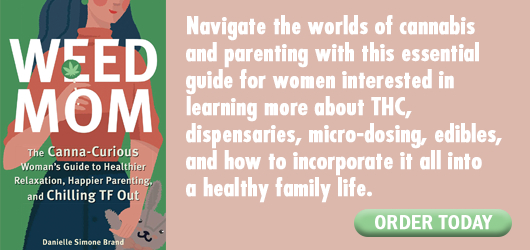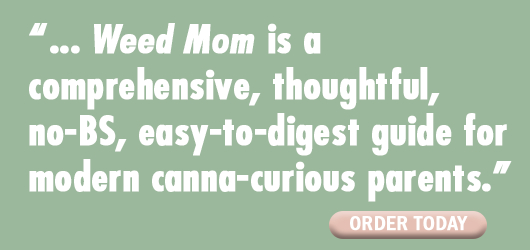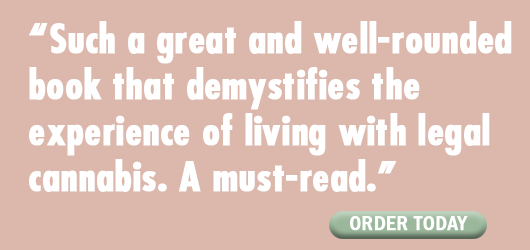Editor-in-Chief Matt Sutherland Interviews Danielle Simone Brand, Author of Weed Mom: The Canna-Curious Woman's Guide to Healthier Relaxation, Happier Parenting, and Chilling TF Out

What’s left of the marijuana-shaming movement is gradually fading into the uninformed backwaters of history—thanks to the diligence of science-based researchers, doctors, and adventurous users who always recognized the promising benefits of cannabis. And now that we’ve entered a golden period of acceptance, we can take our knowledge everywhere the plant wants to lead us.
No matter where you are in your relationship with cannabis—if any at all—it’s important to realize that there’s a learning curve to cannabis, as Danielle Simone Brand explains in the following interview. “It really isn’t a one-size-fits-all kind of deal and takes some trial and error to find what works well for your particular needs.”
She wrote Weed Mom to help you figure it all out.
Intrigued with the provocative title and Danielle’s thoughtful approach, our editor-in-chief asked her to explain some of the book’s most innovative, eye-opening ideas—and she delivers an amazing story.
Your first experience with marijuana found you dropping into some yoga poses, an important passion of yours. Please talk about that first time and how you, reluctantly it seems, became a cannabis convert?
It’s true that I was a reluctant cannabis convert! I didn’t understand or appreciate the plant—and certainly thought it wasn’t for me—until I was a mom of two in my late thirties. At that time, I started learning about cannabis from scientific and historical points of view as a freelance writer and became intrigued, intellectually at least. Writing about cannabis bridges science, health, policy, social justice, culture, and business—a truly fascinating subject. So, when recreational use hit my state of California in January 2018, I decided, out of curiosity, to dip my little toe in the waters of legal cannabis. Many people I’d interviewed, especially moms, told me that cannabis helped them with needs as varied as sleep, pain, mood, and sex, so I wanted to know if it could possibly help me, too. (Spoiler alert: it did!) I was also interested in the long history of conscious cannabis consumption as a boost to creativity, focus, and even spiritual pursuits.
For my first experience with legal cannabis, I inhaled once from a low-dose cannabis vape pen and contemplated how I felt, alone and curious, on my yoga mat. And what followed was nothing short of transporting; my yoga practice, which had been an important part of my life for years, unfolded in a deeply embodied, deeply nourishing way. In chapter 1 of Weed Mom, I describe how I could feel the lengthening and contracting of individual muscles and tune meaningfully into my body and breath while practicing “elevated yoga.” At that moment, I realized that cannabis could enhance my wellbeing as a mother, a professional, and a person—and from there, it was just a short jaunt down the canna-road for me to become a full-on enthusiast and advocate.
Let’s get this question on the board straightaway: Please describe your feelings when you get high?
I think it’s important to note the wide range of experiences people can have with cannabis, depending on the product, dose, and setting of their consumption. I’ve personally had many different experiences ranging from mild relaxation to truly altered states—and much in between. It does take a bit of trial and error to find your own personal sweet spot when consuming cannabis (Weed Mom can help you find it!), but in general I recommend starting with a very low dose and proceeding very slowly to avoid over-consuming.
When I’ve consumed the right product and dose of cannabis along with the right intention, I experience elevation as a mellow, pleasant feeling. My body feels relaxed and ready for movement (I love a good elevated walk or hike!); my mind is present, calm, and open; and I can more easily meditate, practice yoga, do creative projects with my kids, or simply enjoy the feeling of sun touching my skin. Consuming cannabis doesn’t alter my personality or dramatically change the way I feel about my life, family, or work; I’d say, instead, that because cannabis supports my endocannabinoid system to find its own equilibrium, I feel even more like myself—or like the version of myself that thrives without as much of the stress, worry, and mental chatter of contemporary living. You can find several other moms’ descriptions of elevating with cannabis in chapter 2 of Weed Mom.
Regarding Weed Mom, the great title of your book, would you like to take a minute to explain why you chose that title, and, we’re not being judgmental here, are you encouraging mothers of young, middle grade, and teenage children to use cannabis while caring for their children?
The title and (very long) subtitle of my book—The Canna-Curious Woman’s Guide to Healthier Relaxation, Happier Parenting, and Chilling TF Out—was originally suggested by my publisher, Ulysses Press. It sums up what I wanted the title to convey, and I do like a good list. LOL.
The choice to incorporate cannabis into one’s life as a mother is entirely personal; I wrote this guide to help moms who are canna-curious but wary or overwhelmed by the legal marketplace. I also wrote it as something of an anthem for the many “canna-moms” already out there who may be feeling shamed and stigmatized by their choice to consume a plant instead of, say, alcohol or pills.
The book’s message is all about responsible use as a mom: how cannabis can enhance our health and wellbeing so that we’re able to show up for ourselves and our families better than before. That said, there are a lot of considerations around how and when each individual mother will decide to consume cannabis, if at all.
For a lot of moms, CBD feels like a healthy, non-psychotropic way (ie, it won’t get you high) to shift moods and let go of anxiety while parenting. Taking good quality CBD that’s also dosed properly is very low-risk for most people (always check with your doctor first if you have a health condition or are taking prescription medications). Some moms also enjoy micro-doses of THC to help with pain, stress, mood, and a number of other things while spending time with their children, and I cover what that might look like in chapters 5 and 6 of Weed Mom. I emphasize that low-stakes parenting moments where connection is the goal can be optimal times to consume while parenting. Check out chapter 6 for lots more specifics around safety and responsible use.
In the book, you explain that we have our own endocannabinoid system in our bodies that engages with the cannabis plant when we smoke or consume it, something humans have been doing for thousands of years. In fact, you quote Michael Pollan who says that cannabis and humans coevolved, which is an intriguing thought. What does our endocannabinoid system control in our bodies? How does cannabis interact with it?
Our endocannabinoid system helps maintain homeostasis in the body, which means that it has a hand in regulating our mood, appetite, pain signals, sex drive, and many other functions. (Lots more detail in Weed Mom, chapter 2.) Humans naturally produce cannabis-like compounds called endocannabinoids of our own, but it’s theorized that chronic stress actually depletes our inner cannabinoid stores, making it harder for us to reach homeostasis. That’s where, for some of us at least, cannabis comes in! In a sense, I see my cannabis use (and I’m not just talking about THC here) as supplementation that helps me achieve a better balance of sleep, appetite, and mood. Now in my 40s, with regular, conscious cannabis consumption, I feel more physically and emotionally well than I did in my 20s and 30s.
What are your thoughts on CBD? Why does there seem to be such a wide variety of opinions about whether it’s effective?
We have solid research—and FDA backing—of CBD as anti-seizure medicine for some people with severe forms of epilepsy. We don’t yet have solid research on many of the other common uses of CBD today, but we do have a large and growing body of anecdotal evidence, animal studies, and observational studies in humans that indicate CBD may be of help in the arenas of sleep, pain, anxiety, and certain chronic conditions.
But the CBD market is vast and varied; not all CBD is created equal. In Weed Mom, I have guidelines for sourcing quality CBD and for titrating your dose for optimal effects. It’s true that CBD has more subtle effects than THC—which I think causes some confusion or disappointment for folks who want a dramatic shift in their mood when consuming cannabinoids. There’s a learning curve to cannabis in general; it really isn’t a one-size-fits-all kind of deal and takes some trial and error to find what works well for your particular needs. Weed Mom can help you figure it all out.
What does the latest research say about marijuana and teens? Is there a recognized age when the brain/body is developed enough to deal with cannabis?
We don’t have all the research we need on this subject yet, but it’s generally accepted by the medical community that delaying and/or minimizing THC use until after the age of 25—when the pre-frontal cortex is fully developed—is a good idea in most cases. There’s some worry, for instance, that frequent use of highly concentrated THC products may trigger or exacerbate certain mental health conditions like schizophrenia or bipolar disorder in youth.
I want to be clear, though, that plenty of cannabis advocates have pointed out that young people who are predisposed to struggling with mental health issues may self-medicate with cannabis; that doesn’t mean cannabis causes or worsens those conditions. The truth is that we don’t know for sure, though very moderate THC use—particularly when combined with other, non-psychotropic cannabinoids such as CBD—is unlikely to have any long-term negative effects for young adults. There are also many instances where medical THC is appropriate for young people when under a knowledgeable cannabis health care provider’s care.
CBD, on the other hand, is used in various forms (topicals, tinctures, capsules) by some young people to good effect as long as the quality and quantities of the product are well-calibrated.
Because I’m a mother, and this book is geared toward other mothers, I included plenty of information in Weed Mom about kids and cannabis, such as existing research, what we do and don’t know, and how to talk to kids and teens about cannabis in a responsible way.
It’s especially sad that cannabis got off to such a bad start in the US with legal authorities, the media, and public opinion. Why do you think this happened?
Weed Mom, chapter 3, dives into the long history of human-cannabis interaction and what I call the “weird blip” of cannabis prohibition in the last century. For the vast majority of our history and pre-history, people have utilized cannabis in its many forms for building materials, nutrition, medicinal use, celebration, and relaxation. Starting around the 1930s, racism, money, and the exertion of power and control on the part of governments contributed to the demonization and eventual prohibition of the plant. In service of prohibition policies, anti-cannabis propaganda—which effectively spread lies and misinformation about the plant—poisoned mainstream Americans’ perception of cannabis.
Fortunately, the stigmas of prohibition are waning; today, Pew Research shows that 91% of Americans favor medical cannabis legalization and 60% support legal access for all adults.
You mention that the six most common reasons people use medical cannabis are: pain (61.2 percent), anxiety (58.1 percent), depression (50.3 percent, headache/migraines (35.5 percent), nausea (27.4 percent), and muscle spasticity (18.4 percent). Can a reputable cannabis dispensary prescribe specific types and forms of cannabis to address each ailment?
The short answer here is no! I highly recommend that anyone looking to treat a health condition with cannabis consult a cannabis nurse or doctor who specializes in helping patients with cannabinoid therapy. From there, you can rely on a licensed dispensary to help you locate the products and the ratios recommended to you by your practitioner.
Weed Mom focuses on cannabis consumption for wellness and fun—and that’s where I find the most leeway and room for experimentation. Once you understand cannabis, as well as your body’s response to it, you’ll be empowered to utilize cannabis products and dosages to help support different wellness and recreational objectives—such as for help with sleep, sex, mood, stress, minor pain, and lots more! There’s a vast and exciting world of legal cannabis on the horizon, and Weed Mom is the guide to help you bring responsible consumption into a healthy lifestyle.
Matt Sutherland



